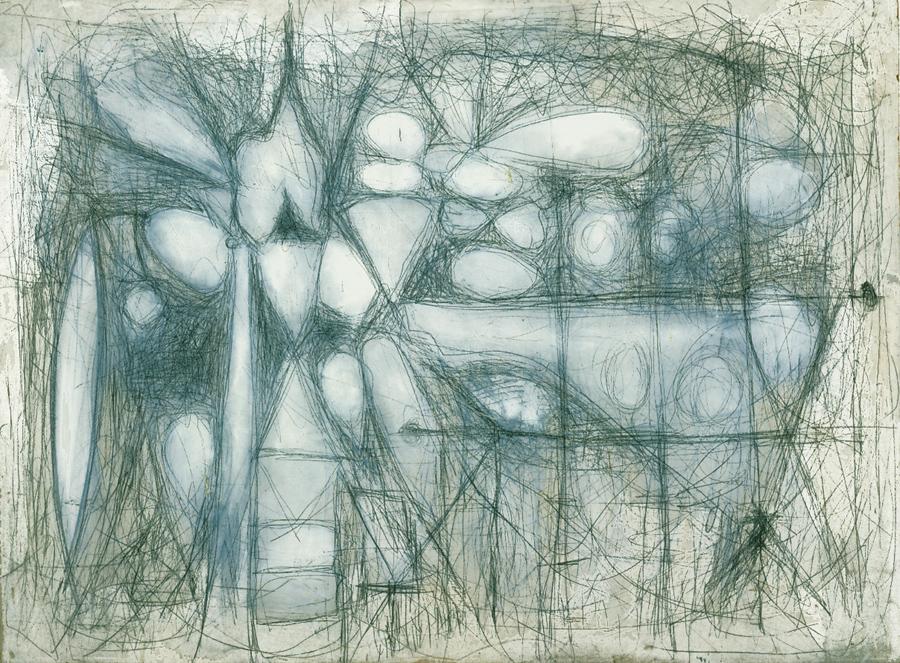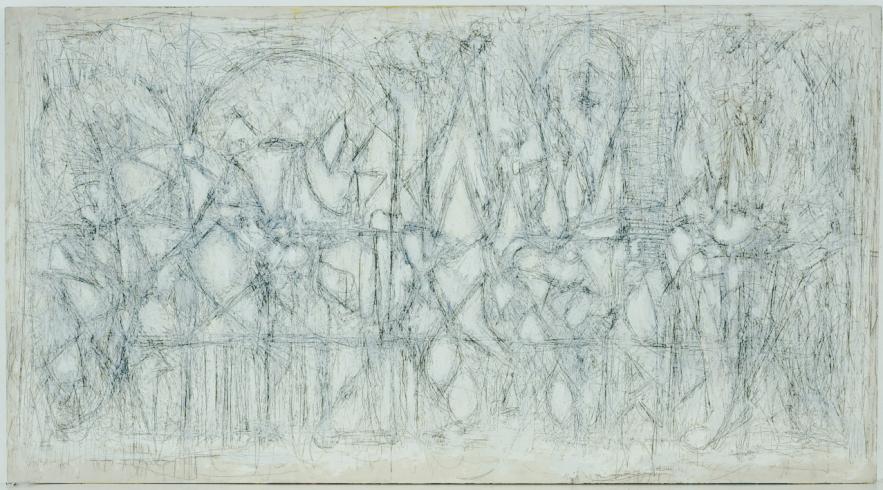Pousette-Dart
Predominantly White Paintings

In the early 1950s, Richard Pousette-Dart (1916–1992) created a series of paintings nearly without paint, working in graphite and oil on canvas to produce works that are both complex and spare. “White,” he said, “is something you endlessly return to.”
About the Exhibition
In the early 1950s, Richard Pousette-Dart (1916–1992) created a series of paintings nearly without paint, working in graphite and oil on canvas to produce works that are both complex and spare. Luminous and poetic, they are filled with symbolic imagery and natural forms, and they represent a dramatic departure from the artist’s more characteristic, richly colored and thickly painted surfaces. Although Pousette-Dart began the white paintings when a shortage of funds prevented him from buying his usual supply of paints, he continued to make mostly white works at intervals in later years. “White,” he said, “is something you endlessly return to.”
Although the paintings read as white from a distance, they are filled with other colors. Pousette-Dart used a variety of white paints, primarily titanium and permalba, to give depth and complexity to his surfaces. He often painted over colored grounds, usually blues, ochers, or browns. In some cases, he re-used his heavily painted and brightly colored canvases, using their thick impasto to add texture to the much more thinly painted white paintings. The predominantly white works are drawings as much as they are paintings. Networks of graphite lines and shapes, geometric and biomorphic by turn, cover their surfaces, lines appearing above and through the paint. In places, the artist articulated the white paint by tamping it with a small cardboard box of the kind that tubes of paint are sold in. In spite of being intensively worked, the surfaces of the predominantly white paintings are somehow fresh and expansive, projecting infinity and enlightenment, in spite of their materiality.
Pousette-Dart grew up in a supportive and artistic environment. His father was a painter, Nathaniel Pousette, and his mother was a poet, Flora Louise Dart. One of his grandfathers was a French silversmith, Algot E. Pousette, Pousette-Dart grew up in a supportively artistic environment. With virtually no formal training as an artist, he dropped out of Bard College in 1936 after only a few months, to work independently as a painter and sculptor. By 1939, he was working fulltime as a painter in New York City. His first solo exhibition took place in New York in 1941. Success came early: Pousette-Dart was the youngest of the abstract expressionists, exhibiting with them from 1944.
Although Pousette-Dart mined many of the same sources as the other abstract expressionists-surrealism, Jungian psychology, and the art of non-Western cultures—his temperament and orientation set him somewhat apart from the New York school. Not a regular at the Cedar Bar, he was introspective, well read, and literary, filling notebooks with writings, as well as drawings, throughout his life. The shapes and symbols that fill his white canvases, as well as his other work, are not tied to fixed meanings. As some of the titles he gave to his works suggest—White Cosmos and White Stillness, for example—he was above all a spiritual man, and it was the spiritual nature of the universe that he said he was trying to express in his paintings.
In 1955, at Betty Parsons Gallery, New York, a gallery closely associated with abstract expressionism, Pousette-Dart first showed his white works, in a one-man exhibition called Predominantly White. The works currently on view at The Phillips Collection in Pousette-Dart: Predominantly White Paintings comprise 23 paintings and works on paper, as well as four sculptures. Several of the works on view were in the 1955 exhibition. Many have not been seen for 50 years.
A book by David Anfam and Carter Ratcliff, published by The Phillips Collection, accompanies this exhibition. The perfect memento for an exquisite show, Pousette-Dart: Predominantly White Paintings is available in the Museum Shop.







